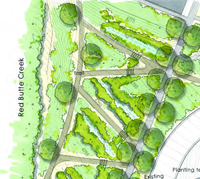
 Although the upper portion of the Red Butte Creek watershed is a protected natural area, the creek’s lower reaches run through the University of Utah campus and have faced over a century of degradation, diversion, and neglect. Graduate students in the 2012 and 2013 Global Changes and Society course recognized this and brought it to the attention of University administration, thus beginning a larger conversation. In 2014-15, the Office of Sustainability, the GCSC, and the Ecological Planning Center carried out a broad engagement and planning process to develop a Strategic Vision for Red Butte Creek, which proposes an approach to revitalize the creek and its watershed and profoundly change the relationship between the university, the surrounding community, and this ecological corridor. The new vision for Red Butte Creek aims to foster healthy ecosystems and build campus sustainability, while advancing the university’s mission as a platform for research, education, and community engagement.
Although the upper portion of the Red Butte Creek watershed is a protected natural area, the creek’s lower reaches run through the University of Utah campus and have faced over a century of degradation, diversion, and neglect. Graduate students in the 2012 and 2013 Global Changes and Society course recognized this and brought it to the attention of University administration, thus beginning a larger conversation. In 2014-15, the Office of Sustainability, the GCSC, and the Ecological Planning Center carried out a broad engagement and planning process to develop a Strategic Vision for Red Butte Creek, which proposes an approach to revitalize the creek and its watershed and profoundly change the relationship between the university, the surrounding community, and this ecological corridor. The new vision for Red Butte Creek aims to foster healthy ecosystems and build campus sustainability, while advancing the university’s mission as a platform for research, education, and community engagement.
The Williams Building property in the University of Utah’s Research Park offers a unique opportunity to host a demonstration project for the Red Butte Creek Strategic Vision. In partnership with campus facilities and planning and the Real Estate Administration, the Office of Sustainability, the GCSC, and the Ecological Planning Center convened a collaborative design process—the “Landscape Lab”—to re-design the landscape of the Williams Building. Facilitated by a landscape architecture consultant, the research design team has worked to weave ecological and social-impact research questions into the design and construction of the new landscape, thereby encouraging a new process model that merges social science and ecological research with planning and design.
Through this collaboration, the project will restore native ecological diversity and function to this portion of the Red Butte Creek watershed; increase access to recreational space for occupants of the building, the campus community, and the public; as well as test research questions about urban stream restoration, stormwater management, water quality, use of public space, and more. By working across disciplines, this investigative process aims to shorten the feedback loop between implementation and research, ultimately helping to shape more effective designs for healthy and resilient ecosystems and communities.
This project is funded with support from the Real Estate Administration for the University of Utah Research Park, with supplemental funds coming from individual research grants. There are ongoing opportunities for interested faculty and students to engage with this project.
